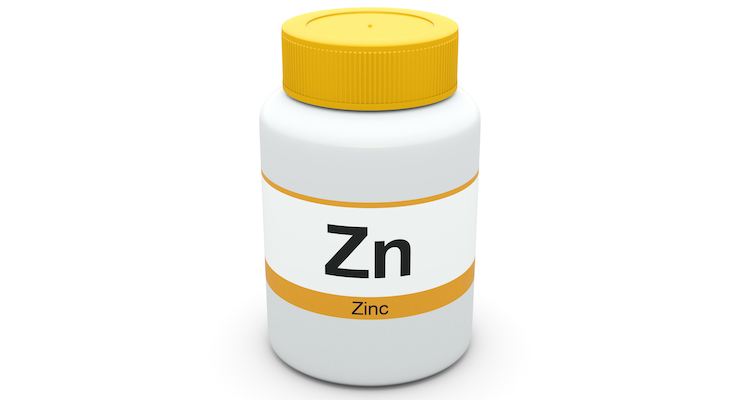11.23.21
A team of food scientists at Cornell University recently developed an index test to evaluate zinc concentrations in the human body.
Zinc deficiency, which is globally prevalent and can lead to health problems, especially when it comes to reproductive health and the cognitive development of children. Additionally, zinc plays a functional role in immune function, metabolism, wound healing, and other functions. The new zinc index test comes at a time when the World Health Organization specifically said it is seeking out a way to reliably measure zinc concentrations in humans, especially due to the fact that an estimated 17% of the world’s population is zinc deficient.
In addition to being able to determine zinc deficiency, the Zinc Status Index will serve as a valuable tool for linking accurate zinc concentrations within the human body, and not just zinc consumption, to various health outcomes in clinical settings.
“With global food insecurity and increasing domestic obesity rates, malnutrition is hitting vulnerable and low-income populations. These issues are a major concern, as they can lead to dietary zinc deficiency,” Elad Tako, associate professor of food science in the College of Agriculture and Life Sciences at Cornell University, said. “Because of the complexity and sophistication of zinc metabolism, it is very difficult to accurately measure zinc status.”
The index was developed with Jacquelyn Cheng, doctoral student in food science, and Haim Bar, PhD, associate professor at the University of Connecticut. The authors reported on its development in a paper, “Zinc Status Index (ZSI) for Qualification of Zinc Physiological Status,” which appeared in the journal Nutrients on September 27.
The ZSI measures zinc metabolism in the human body through three markers, based on a review of five different analyses which correlated certain health markers with zinc deficiency. While one marker alone can easily determine severe zinc deficiencies, more sensitive measurements are needed via a suite of biomarkers to accurately assess less severe cases.
The first is the ratio of linolenic acid to dihomo-gamma-linolenic acid, a biomarker which correlates to zinc concentrations. Another marker the index uses, which is impacted by zinc status, is gene expression of zinc dependent proteins. Additionally, measurements of the gut microbiome are among the suite of tools in the index, as a reflection of a person’s zinc physiological status.
“This research presents a significant advancement in the field of zinc nutrition and the associated physiological status,” Cheng said. “Using the Zinc Status Index will provide a better understanding of the challenges that are linked to poor zinc nutrition, and improve the ability to quantify the impact of dietary interventions aimed at alleviating zinc deficiency.”
The research done in developing the ZSI also determined that zinc has an effect on gene expression in the body, and that the intestine’s microbial environment is more crucial for zinc metabolism than previously thought, as a lack of zinc adversely effects the composition of the gut microbiome.
Zinc deficiency, which is globally prevalent and can lead to health problems, especially when it comes to reproductive health and the cognitive development of children. Additionally, zinc plays a functional role in immune function, metabolism, wound healing, and other functions. The new zinc index test comes at a time when the World Health Organization specifically said it is seeking out a way to reliably measure zinc concentrations in humans, especially due to the fact that an estimated 17% of the world’s population is zinc deficient.
In addition to being able to determine zinc deficiency, the Zinc Status Index will serve as a valuable tool for linking accurate zinc concentrations within the human body, and not just zinc consumption, to various health outcomes in clinical settings.
“With global food insecurity and increasing domestic obesity rates, malnutrition is hitting vulnerable and low-income populations. These issues are a major concern, as they can lead to dietary zinc deficiency,” Elad Tako, associate professor of food science in the College of Agriculture and Life Sciences at Cornell University, said. “Because of the complexity and sophistication of zinc metabolism, it is very difficult to accurately measure zinc status.”
The index was developed with Jacquelyn Cheng, doctoral student in food science, and Haim Bar, PhD, associate professor at the University of Connecticut. The authors reported on its development in a paper, “Zinc Status Index (ZSI) for Qualification of Zinc Physiological Status,” which appeared in the journal Nutrients on September 27.
The ZSI measures zinc metabolism in the human body through three markers, based on a review of five different analyses which correlated certain health markers with zinc deficiency. While one marker alone can easily determine severe zinc deficiencies, more sensitive measurements are needed via a suite of biomarkers to accurately assess less severe cases.
The first is the ratio of linolenic acid to dihomo-gamma-linolenic acid, a biomarker which correlates to zinc concentrations. Another marker the index uses, which is impacted by zinc status, is gene expression of zinc dependent proteins. Additionally, measurements of the gut microbiome are among the suite of tools in the index, as a reflection of a person’s zinc physiological status.
“This research presents a significant advancement in the field of zinc nutrition and the associated physiological status,” Cheng said. “Using the Zinc Status Index will provide a better understanding of the challenges that are linked to poor zinc nutrition, and improve the ability to quantify the impact of dietary interventions aimed at alleviating zinc deficiency.”
The research done in developing the ZSI also determined that zinc has an effect on gene expression in the body, and that the intestine’s microbial environment is more crucial for zinc metabolism than previously thought, as a lack of zinc adversely effects the composition of the gut microbiome.




























